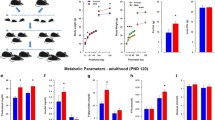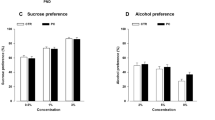Abstract
Rationale
Early environment can shape the development and function of the mesocorticolimbic dopamine (DA) system and represents a possible risk factor for adult pathologies. One critical variable in the early environment is nutrition, and exposure to high fat (HF) in adulthood is known to change this DA system.
Objectives
We tested whether perinatal HF intake in rats could have long-term effects on DA function and behavior in adult offspring.
Materials and methods
Rat dams were fed either a control (5% fat, CD) or high fat (30% fat, HF) diet during the last week of gestation and lactation, and adult offspring were tested (PND 56–90) after weaning on CD. Locomotor responses to acute and repeated doses of d-amphetamine (AMP, 0.75 mg/kg bw) were determined as were indices of DA function in the ventral tegmental area (VTA), nucleus accumbens (NAc), and the prefrontal cortex (PFC).
Results
Adult HF offspring displayed increased tyrosine hydroxylase expression in the VTA and NAc and significant increases in DA and DOPAC content in the NAc, suggesting an elevated DA tone in this target field. In the NAc, there were no significant changes in D1, D2 receptors, or DA transporter (DAT) levels between diet groups. Perinatal HF feeding reduced AMP-induced locomotion and behavioral sensitization to AMP, suggesting that early diet might have caused long-lasting desensitization of postsynaptic receptor mechanisms in the NAc.
Conclusions
Our results demonstrate that both synthetic activity in VTA neurons and the responsiveness of accumbens DA neurons is altered by maternal nutrition. These effects subside long after termination of exposure to the HF diet.





Similar content being viewed by others
References
Antonopoulos J, Dori I, Dinopoulos A, Chiotelli M, Parnavelas JG (2002) Postnatal development of the dopaminergic system of the striatum in the rat. Neuroscience 110(2):245–56
Bayer VE, Pickel VM (1990) Ultrastructural localization of tyrosine hydroxylase in the rat ventral tegmental area: relationship between immunolabeling density and neuronal associations. J Neurosci 10(9):2996–3013
Berthoud HR (2007) Interactions between the “cognitive” and “metabolic” brain in the control of food intake. Physiol Behav 91(5):486–498
Bhardwaj SK, Beaudry G, Quirion R, Levesque D, Srivastava LK (2003) Neonatal ventral hippocampus lesion leads to reductions in nerve growth factor inducible-B mRNA in the prefrontal cortex and increased amphetamine response in the nucleus accumbens and dorsal striatum. Neuroscience 122(3):669–676
Bouret SG, Draper SJ, Simerly RB (2004) Trophic action of leptin on hypothalamic neurons that regulate feeding. Science 304(5667):108–110
Brake WG, Sullivan RM, Gratton A (2000) Perinatal distress leads to lateralized medial prefrontal cortical dopamine hypofunction in adult rats. J Neurosci 20(14):5538–5543
Brake WG, Zhang TY, Diorio J, Meaney MJ, Gratton A (2004) Influence of early postnatal rearing conditions on mesocorticolimbic dopamine and behavioural responses to psychostimulants and stressors in adult rats. Eur J Neurosci 19(7):1863–1874
Champagne FA, Chretien P, Stevenson CW, Zhang TY, Gratton A, Meaney MJ (2004) Variations in nucleus accumbens dopamine associated with individual differences in maternal behavior in the rat. J Neurosci 24:4113–4123
Corda MG, Piras G, Giorgi O (2006) Neonatal ventral hippocampal lesions potentiate amphetamine-induced increments in dopamine efflux in the core, but not the shell, of the nucleus accumbens. Biol Psychiatry 60(11):1188–1195
Figlewicz DP (2003) Adiposity signals and food reward: expanding the CNS roles of insulin and leptin. Am J Physiol Regul Integr Comp Physiol 284(4):R882–R892
Figlewicz DP, Evans SB, Murphy J, Hoen M, Baskin DG (2003) Expression of receptors for insulin and leptin in the ventral tegmental area/substantia nigra (VTA/SN) of the rat. Brain Res 964(1):107–115
Figlewicz DP, Bennett J, Evans SB, Kaiyala K, Sipols AJ, Benoit SC (2004) Intraventricular insulin and leptin reverse place preference conditioned with high-fat diet in rats. Behav Neurosci 118(3):479–487
Fulton S, Woodside B, Shizgal P (2000) Modulation of brain reward circuitry by leptin. Science 287(5450):1931
Fulton S, Richard D, Woodside B, Shizgal P (2004) Food restriction and leptin impact brain reward circuitry in lean and obese Zucker rats. Behav Brain Res 155(2):319–329
Fulton S, Pissios P, Manchon RP, Stiles L, Frank L, Pothos EN, Maratos-Flier E, Flier JS (2006) Leptin regulation of the mesoaccumbens dopamine pathway. Neuron 51(6):811–822
Gentry WB, Ghafoor AU, Wessinger WD, Laurenzana EM, Hendrickson HP, Owens SM (2004) (+)-Methamphetamine-induced spontaneous behavior in rats depends on route of (+)METH administration. Pharmacol Biochem Behav 79(4):751–760
Godfrey KM, Barker DJ (2001) Fetal programming and adult health. Public Health Nutr 24(2B):611–624
Hendrickson H, Laurenzana E, Owens SM (2006) Quantitative determination of total methamphetamine and active metabolites in rat tissue by liquid chromatography with tandem mass spectrometric detection. AAPS J 8(4):E709–E717
Hommel JD, Trinko R, Sears RM, Georgescu D, Liu ZW, Gao XB, Thurmon JJ, Marinelli M, DiLeone RJ (2006) Leptin receptor signaling in midbrain dopamine neurons regulates feeding. Neuron 51(6):801–810
Huang XF, Yu Y, Zavitsanou K, Han M, Storlien L (2005) Differential expression of dopamine D2 and D4 receptor and tyrosine hydroxylase mRNA in mice prone, or resistant, to chronic high-fat diet-induced obesity. Brain Res Mol Brain Res 135(1–2):150–161
Huang XF, Zavitsanou K, Huang X, Yu Y, Wang H, Chen F, Lawrence AJ, Deng C (2006) Dopamine transporter and D2 receptor binding densities in mice prone or resistant to chronic high fat diet-induced obesity. Behav Brain Res 175(2):415–419
Hutson PH, Bristow LJ, Thorn L, Tricklebank MD (1991) R-(+)-HA-966, a glycine/NMDA receptor antagonist, selectively blocks the activation of the mesolimbic dopamine system by amphetamine. Br J Pharmacol 103(4):2037–2044
Kalsbeek A, Voorn P, Buijs RM, Pool CW, Uylings HB (1988) Development of the dopaminergic innervation in the prefrontal cortex of the rat. J Comp Neurol 269(1):58–72
Karler R, Calder LD, Turkanis SA (1991) DNQX blockade of amphetamine behavioral sensitization. Brain Res 552(2):295–300
Karler R, Calder LD, Chaudhry IA, Turkanis SA (1989) Blockade of “reverse tolerance” to cocaine and amphetamine by MK-801. Life Sci 45(7):599–606
Kelley AE, Baldo BA, Pratt WE, Will MJ (2005) Corticostriatal–hypothalamic circuitry and food motivation: integration of energy, action and reward. Physiol Behav 86(5):773–795
Kokoeva MV, Yin H, Flier JS (2005) Neurogenesis in the hypothalamus of adult mice: potential role in energy balance. Science 310(5748):679–683
Kretschmer BD (1999) Modulation of the mesolimbic dopamine system by glutamate: role of NMDA receptors. J Neurochem 73(2):839–848
Krugel U, Schraft T, Kittner H, Kiess W, Illes P (2003) Basal and feeding-evoked dopamine release in the rat nucleus accumbens is depressed by leptin. Eur J Pharmacol 482(1–3):185–187
Kuczenski R, Segal DS (1990) In vivo measures of monoamines during amphetamine-induced behaviors in rats. Prog Neuropsychopharmacol Biol Psychiatry 14(Suppl):S37–S50
Liang NC, Hajnal A, Norgren R (2006) Sham feeding corn oil increases accumbens dopamine in the rat. Am J Physiol Regul Integr Comp Physiol 291(5):R1236–R1239
Long H, Walker C-D (2005) Postnatal leptin treatment increases neurogenesis and neuronal survival in the hippocampus of developing rats Abstract for the 35th annual meeting of the Society for Neuroscience, Washington DC, November 12–16, 2005
Lovic V, Fleming AS, Fletcher PJ (2006) Early life tactile stimulation changes adult rat responsiveness to amphetamine. Pharmacol Biochem Behav 84(3):497–503
Margolis EB, Lock H, Hjelmstad GO, Fields HL (2006) The ventral tegmental area revisited: is there an electrophysiological marker for dopaminergic neurons. J Physiol 577(Pt 3):907–924
Milesi-Halle A, Hendrickson HP, Laurenzana EM, Gentry WB, Owens SM (2005) Sex- and dose-dependency in the pharmacokinetics and pharmacodynamics of (+)-methamphetamine and its metabolite (+)-amphetamine in rats. Toxicol Appl Pharmacol 209(3):203–213
Munzberg H, Flier JS, Bjorbaek C (2004) Region-specific leptin resistance within the hypothalamus of diet-induced obese mice. Endocrinology 145(11):4880–4889
Nehlig A (2004) Brain uptake and metabolism of ketone bodies in animal models prostaglandins. Leukot Essent Fatty Acids 70(3):265–275
Paxinos G, Watson C. The Rat Brain in stereotaxic coordinates (2005). 5th edition Elsevier Academic
Pierce RC, Kalivas PW (1997) A circuitry model of the expression of behavioral sensitization to amphetamine-like psychostimulants. Brain Res Brain Res Rev 25:192–216
Plagemann A (2006) Perinatal nutrition and hormone-dependent programming of food intake. Horm Res 65(Suppl 3):83–89
Plum L, Schubert M, Bruning JC (2005) The role of insulin receptor signaling in the brain. Trends Endocrinol Metab 16(2):59–65
Sharp T, Zetterstrom T, Ljungberg T, Ungerstedt U (1987) A direct comparison of amphetamine-induced behaviours and regional brain dopamine release in the rat using intracerebral dialysis. Brain Res 401(2):322–30
Riviere GJ, Gentry WB, Owens SM (2000) Disposition of methamphetamine and its metabolite amphetamine in brain and other tissues in rats after intravenous administration. J Pharmacol Exp Ther 292(3):1042–1047
Seeley RJ, Woods SC (2003) Monitoring of stored and available fuel by the CNS: implications for obesity. Nat Rev Neurosci 4(11):901–909
Shizgal P, Fulton S, Woodside B (2001) Brain reward circuitry and the regulation of energy balance. Int J Obes Relat Metab Disord 25(Suppl 5):S17–S21
Szot P, White SS, Veith RC, Rasmussen DD (1999) Reduced gene expression for dopamine biosynthesis and transport in midbrain neurons of adult male rats exposed prenatally to ethanol. Alcohol Clin Exp Res 23(10):1643–1649
Trottier G, Koski KG, Brun T, Toufexis DJ, Richard D, Walker C-D (1998) Increased fat intake during lactation modifies hypothalamic–pituitary adrenal responsiveness in developing rat pups: a possible role for leptin. Endocrinology 139(9):3704–3711
Tzschentke TM (2001) Pharmacology and behavioral pharmacology of the mesocortical dopamine system. Prog Neurobiol 63(3):241–320
Walker C-D, Deschanps S, Proulx K, Tu M, Salzman C, Woodside B, Lupien S, Gallo-Payet N, Richard D (2004) Mothers to infant of infant to mother? Reciprocal regulation of responsiveness to stress in rodents and the implications for humans. J Psychiatry Neurosci 29:364–382
Walker C-D, Long H, Williams S, Richard D (2007) Long-lasting effects of neonatal leptin on hippocampal function, synaptic proteins and NMDA receptor subunits in the rat. J Neurosci Res 85(4):816–828
Weaver IC, Champagne FA, Brown SE, Dymov S, Sharma S, Meaney MJ, Szyf M (2005) Reversal of maternal programming of stress responses in adult offspring through methyl supplementation: altering epigenetic marking later in life. J Neurosci 25(47):11045–11054
Woods SC, D'Alessio DA, Tso P, Rushing PA, Clegg DJ, Benoit SC, Gotoh K, Liu M, Seeley RJ (2004) Consumption of a high-fat diet alters the homeostatic regulation of energy balance. Physiol Behav 83(4):573–578
Acknowledgements
We would like to thank Hong Long, Susan Xu, and Luc Moquin for their expert help with the animals, the autoradiography, and the use of the LC-EC system. This work was supported by a grant from the Canadian Institutes for Health Research (CIHR) grant #FRN 53350 to CDW and by a fellowship from the Fonds de Recherche en Santé du Quebec (FRSQ) to LN, and by a grant from the National Institute on Drug Abuse DA07610 to SMO.
Disclosure/Conflict of interest
All authors recognize having no potential or real conflict of interest related to the subject of the present report.
Author information
Authors and Affiliations
Corresponding author
Rights and permissions
About this article
Cite this article
Naef, L., Srivastava, L., Gratton, A. et al. Maternal high fat diet during the perinatal period alters mesocorticolimbic dopamine in the adult rat offspring: reduction in the behavioral responses to repeated amphetamine administration. Psychopharmacology 197, 83–94 (2008). https://doi.org/10.1007/s00213-007-1008-4
Received:
Accepted:
Published:
Issue Date:
DOI: https://doi.org/10.1007/s00213-007-1008-4




